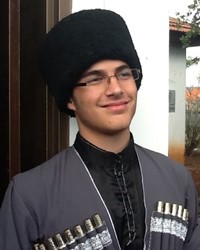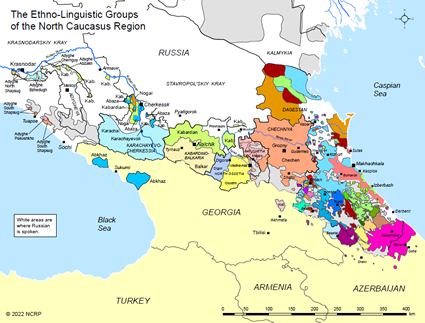There are two main groups of Circassians: West, or Lower Circassian, who speak Adyghe; and the East, or Upper Circassian, who speak Kabardian. Their original homeland was an area in the northwestern Caucasus Mountains, extending out onto the Russian steppes. It was bounded on the west by the Black Sea, on the northwest by the Crimea, on the north by Ukraine, and on the east by Chechnya and Dagestan. The Adyghe of Russia represent a relatively small amount of a once large group of people. Having lived in the Caucasus area for thousands of years, they had contact with the many peoples who passed the steppes to the north. During that time, the Adyghe knew almost constant warfare with these neighbors. By the mid-1860s, roughly 90% of the Adyghe population had been either killed or forced to flee. Today, they live not only in their own homeland, but also in Turkey, Syria, Jordan, and Iraq and other countries.
Adyghe in Russia are largely a rural people. Their traditional economy is based on herding and farming, supplemented by growing fruit. They also raise chickens, cows, sheep, goats, pigs and especially horses. They grow a variety of grains, and in the highlands, they also hunt. They eat bread, milk, cheese, broth, fruit, vegetable dishes and occasionally a meat dish with a spicy nut sauce.
Traditionally, Adyghe houses were spaced far apart along a river, generally in the higher country. The dwelling, called a wuna, was a long rectangular house with a porch extending along its front. It was made of twigs coated with mud and had a thatch roof. There were several rooms, including at least one for the women. The house usually had a large tree planted in front of its door to symbolize the growth and strength of the family. A vegetable garden and several other houses (for sons and their families), as well as buildings for livestock and food storage were located behind the main house. The entire compound was enclosed in a stockade. Today, in the lowland villages where most of the people live, standardized brick homes with garden plots have replaced traditional patterns.
Many Adyghe now live in the cities of Maikop, Armavir, Krasnodar, Cherkassk, Stavrapol, Nalchik, and Mozdok. These centers have Adyghe institutes and schools, and some Adyghe have moved there to be near their work. Outside of the cities, the extended family is the most common unit, sometimes containing as many as four or five generations.
Members of a tlapq (clan) are descended from the same male ancestors and share a common name. Marriages are based on love or mutual interest and occur when the couple is in their early thirties. The wife has authority over many of the household matters, but the husband has the final say in disputes. A man was traditionally never without his dagger, and few things were more important to him than his weapons. This reflected the prevalence of the "blood feud." Adyghe folklore has served as a basis for modern literature and poetry. In recent years, the areas in which Adyghe live were elevated in status to republics and are allowed to fly the old Adyghe flag. An effort is now being made, through land grants and other incentives, for scattered Adyghe return to their homeland. In fact, a number have returned, and some even dream of the return of all Adyghes to the Caucasus.
Christianity was brought to the Adyghe between the sixth and twelfth centuries, but they have been Muslims for the past three or four hundred years. Nevertheless, many pagan relics and some forms of Eastern Orthodox Christianity still exist in their oral traditions and religious practices.
Although the New Testament and Bible portions have been translated into the Adyghe language of the Adyghe people, they continue to have an unworking knowledge of God's Word. Who will tell them?
Pray blessing on noticeable increasing spiritual impact thru new incarnational ministry presence from Russian evangelicals, in the midst of Adyghe culture.
Ask the Lord to save key leaders among the Adyghe who will boldly declare the gospel, establishing disciple among families, and planting strong local churches among them.
Pray for translators to complete the whole Bible in Adyghe by 2028.
Pray for Scripture engagement efforts into this culture.
Pray for Christian media to be translated into Adyghe.
Ask Almighty God to raise up prayer teams who will begin breaking up the soil through worship and intercession.
Scripture Prayers for the Adyghe, West Circassian in Russia.
| Profile Source: Joshua Project |
| Other PDF Profile |












